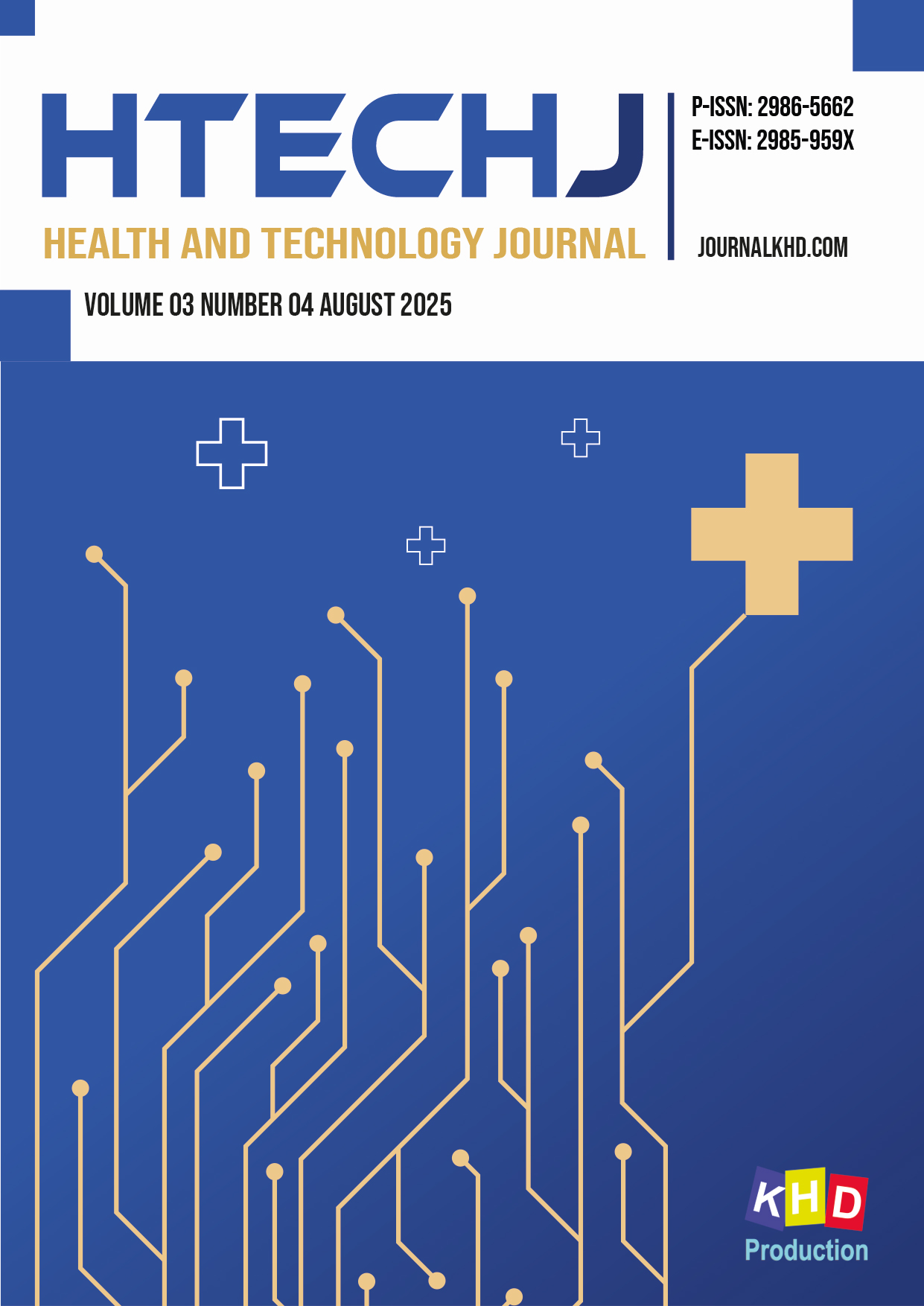Nurses' Roles in the Implementation of the Fourth Patient Safety Goals: Literature Review
DOI:
https://doi.org/10.53713/htechj.v3i4.397Keywords:
nurse role, surgical, patient safety, surgical safety checklistAbstract
Patient safety is a critical component of healthcare quality. Surgical procedures pose significant risks, with frequent incidents such as wrong-site surgeries and retained surgical instruments. To mitigate these risks, the Fourth Patient Safety Goals emphasize the correct site, correct procedure, and correct surgical patient. Nurses, who are involved in every stage of surgical care, play a vital role in ensuring of the correct site, procedure, and surgical patient. The objective of this research is to analyze and identify the role of nurses in implementing the Fourth Patient Safety Goal, specifically in ensuring the correct site, procedure, and patient in surgical settings. This study employed a literature review method using databases including Google Scholar, PubMed, and Science Direct. A total of 11 articles published between 2024 and 2025 were selected using inclusion and exclusion criteria based on the PICO(S) approach. Article quality was assessed using JBI Appraisal Tools. The findings show that nurses contribute significantly to all three phases of the Surgical Safety Checklist (sign in, time out, sign out). Their roles include verifying surgical information, ensuring team communication, providing emotional support for patients, coordinating interdisciplinary collaboration, and integrating technology-based tools. Barriers identified include lack of training, incomplete documentation, and limited compliance with protocols. Nurses play a central role in ensuring the correct site, procedure, and surgical patient. Strengthening their competence, fostering interprofessional collaboration, and applying technological innovations are essential strategies to enhance patient safety in surgical settings.
References
Afandi, A. T., Candrayani, M., Ardiana, A., & Fariasih, C. (2023). Interprofessional Collaboration in Patients Diabetes Mellitus: A Case Study. Jurnal Kesehatan Komunitas Indonesia (JKKI), 3(1), 126–136.
Afandi, A. T., Maula, M., Asmaningrum, N., & Puthra, G. D. (2024). The Six Right Principles of Drug Administration to Patients with Diabetes Mellitus in Hospitals: A Case Study. Jurnal Kesehatan Komunitas Indonesia (JKKI), 4(1), 21–35.
Afandi, A. T., Pramita, A. D., Rosyidi, K., & Nur, M. (2023). Gambaran Budaya Keselamatan Pasien di Rumah Sakit : Studi Kasus pada Area Manajemen Pelayanan. SEHATMAS (Jurnal Ilmiah Kesehatan Masyarakat), 2(4), 894–902. https://doi.org/10.55123/sehatmas.v2i4.2358
Afandi, A. T., Safitri, R. I., Wijaya, D., & Fariasih, C. (2023). Implementation of Supervision About Patient Safety with an Inguinal Hernia Diagnosed in an Inpatient Room : A Case Study. D’Nursing and Health Journal (DNHJ), 4(1), 67–88.
Alotaibi, Y. K., & Federico, F. (2017). The impact of health information technology on patient safety. Saudi Medical Journal, 38(12), 1173–1180. https://doi.org/10.15537/smj.2017.12.20631
Gousario, Y., Manafe, H. A., Perseveranda, M. E., & Paridy, A. (2023). Penerapan Keselamatan Pasien Preoperasi dan Post Operasi di Rumah Sakit. Jurnal Ilmiah Universitas Batanghari Jambi, 23(2), 2018. https://doi.org/10.33087/jiubj.v23i2.3579
Larsson, F., & Engström, Å. (2024). Feeling Safe in the Perioperative Period : Experiences from Patients Undergoing Orthopedic Day Surgery. SAGE Open Nursing, 10, 1–9. https://doi.org/10.1177/23779608241258562
Menteri Kesehatan Republik Indonesia. (2017). Peraturan Menteri Kesehatan Republik Indonesia Nomor 11 Tahun 2017 Tentang Keselamatan Pasien. In Kementerian Kesehatan Republik Indonesia (pp. 1–58).
Mulyatiningsih, S., & Sasyari, U. (2021). Gaya Kepemimpinan Yang Efektif Dalam Meningkatkan Keselamatan Pasien. Healthcare Nursing Journal, 3(1), 59–64. https://doi.org/10.35568/healthcare.v3i1.1093
Nugrahaeni, S. W., Yuliani, N., & Veliana, A. D. (2021). Studi literatur : Budaya Keselamatan Pasien dan Insiden Keselamatan Pasien di Rumah Sakit. Prosiding Seminar Informasi Kesehatan Nasional (SIKesNas), 290–295.
Pratiwi, A. P. (2023). HUBUNGAN PENGETAHUAN PERAWAT DENGAN PENERAPAN PATIENT SAFETY. 12(April 2022), 50–56.
Purwanti, N., Saputra, C., Guna, S. D., Azhar, B., Malfasari, E., & Pratiwi, P. I. (2022). Faktor Penerapan Surgical Safety Checklist di Kamar Operasi. Jurnal Keperawatan STIKES Kendal, 14(1), 291–300.
Putri, P., & Afandi, A. T. (2023). The SBAR Communication Method (Situation-Background- Assessment-Recommendation) In Nursing: A Literature Review. Jurnal Kesehatan Komunitas Indonesia (JKKI), 3(2), 194–200.
Rasyid, M. E. S., Menap, & Supinganto, A. (2024). Determinan Faktor Kepatuhan Tim Bedah Dalam Penerapan Surgical Safety Checklist Pada Pasien Bedah Di Instalasi Bedah Sentral. Jurnal Keperawatan, 15(S4), 539–552.
Riyanto, O. S., Panggabean, H. W. A., Kurniawan, E. A. P. B., & Hitauruk, M. (2022). Kedudukan Hukum Perawat Bedah Pasca Pembedahan dalam Sengketa Medis di Rumah Sakit. AL-MANHAJ: Jurnal Hukum Dan Pranata Sosial Islam, 4(2), 199–206. https://doi.org/10.37680/almanhaj.v4i2.1784
Salawati, L. (2020). Penerapan Keselamatan Pasien Rumah Sakit. AVERROUS: Jurnal Kedokteran Dan Kesehatan Malikussaleh, 6(1), 94. https://doi.org/10.29103/averrous.v6i1.2632
Silva, L. de L. T., Lima, R. C. de, Silva, R. I. da, & Poveda, V. de B. (2024). Safe care mobile application for surgical patients : development , content validation , and usability validation. Revista Gaúcha de Enfermagem, 45, 1–11.
Sulastri, S., Trilianto, A. E., & Ermaneti, Y. (2019). Pengaruh Komunikasi Terapeutik Perawat terhadap Tingkat Kecemasan pada Pasien Pre Operasi. Jurnal Keperawatan Profesional, 7(1). https://doi.org/10.33650/jkp.v7i1.503
Suryathi, N. K., Sukmandari, N. M. ., & Wulandari, M. R. . (2021). Hubungan Tingkat Pengetahuan Perawat tentang Time Out dengan Kepatuhan dalam melakukan Time Out di Ruang Operasi Rumah Sakit Balimed Denpasar. Bali Health Published Journal, 3(1), 54–64. https://doi.org/10.47859/bhpj.v3i1.1
Trilaksana, M., Handriyanto, C. F., & Qomariah, S. N. (2023). Analisis Faktor yang Berhubungan dengan Kepatuhan Perawat dalam Pelaksanaan Surgical Patient Safety. Journal of Industrial Safety and Health, 01(01), 1–11.
Vatn, L., & Dahl, B. M. (2022). Interprofessional collaboration between nurses and doctors for treating patients in surgical wards. Journal of Interprofessional Care, 36(2), 186–194. https://doi.org/10.1080/13561820.2021.1890703








